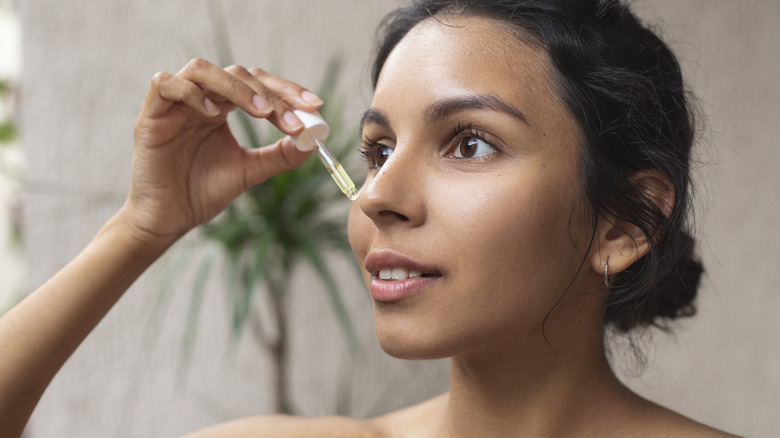What Exactly Is Dry Oil Anyways? Inside The Name And Benefits
We may receive a commission on purchases made from links.
The idea of a dry oil is slightly confusing. Dryness is the opposite of oily after all, so how can an oil be dry? Not to worry — it's not as complicated as it might seem. But before we get into the details, let's break down the basics. Dry oils are a type of oil that is frequently used in hair care and skin care. These oils are characterized by their ability to absorb quickly and thus, leave your hair and skin feeling almost as dry as they were before application. Wet oils, in contrast, tend to linger on the hair and skin, leaving behind that oily feeling some may find annoying, and others may enjoy.
Dry oils are still oils — but they simply soak into the skin differently than wet oils. Some of the most common dry oils include sesame oil, avocado oil, sunflower oil, jojoba oil, and grapeseed oil, among others. Each of these oils has its own benefits for your face, body, and hair that can suit your beauty needs. When you're ready to switch up your moisturization strategy and incorporate dry oils into your beauty routine, here's how to get started.
Benefits of dry oil for hair
Because our hair is made out of dead skin cells, keeping our hair healthy is certainly a worthy task. To be more clear, our hair is made up of dead cells plus the protein keratin, according to Visible Body, which gives our hair (and nails) their form. When experts talk about keeping hair moisturized, which is different than hydration, they mean ensuring that your hair has enough oil in it to prevent it from weakening and becoming damaged. This is where dry oils come in.
One of the main benefits of dry oil for hair is how they feel when applied. Where wet oils on hair could make the hair feel greasy, dry oils keep the greasiness to a minimum. Wet oils can also weigh down the hair, thus depleting it of volume, whereas dry oils tend to be slightly lighter in weight. Many popular haircare brands use dry oils in their hair products. Olaplex, for example, uses several dry oils in its No. 7 Bonding Hair Oil, which is used for styling and nourishment. These include grapeseed oil, green tea oil, and sunflower seed oil. Another haircare brand, Ouai, uses sweet almond oil, jojoba oil, sunflower seed oil, and others to moisturize the hair. But in addition to its nourishing properties, hair oils also make a great defense mechanism against stressors including heat from your hot tools.
Benefits of dry oil for skin
Much like your hair, your skin needs oil to stay moisturized. According to UT Medical Center, moisturized skin is less prone to dryness, inflammation, and breakouts, among other skin conditions. But one of the most essential benefits of dry oils over wet oils is that they're easier on the skin for those who are prone to breakouts or excess oil production. Certain oils can be comedogenic, meaning they can clog your pores, eventually leading to breakouts. Dry oils, however, like sunflower oil, camelina oil, and rosehip seed oil tend to be non-comedogenic. Just keep in mind that, like most all cosmetic products, oils do have a shelf life and facial oils should be used within nine to 12 months.
When choosing an oil or oil blend for your skin, first asses your skin type to ensure that you're choosing the right product for you. When you have sensitive skin, acne-prone skin, or skin that skews on the oily side, make sure that the facial oils you use are indeed formulated with dry oils, and with your skin concerns in mind. The Paula's Choice Moisture Renewal Oil Booster, for example, uses several plant oils including jojoba oil and sunflower seed oil, where each may hone in on a specific skin concern.


